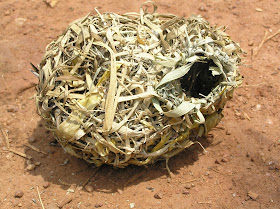 |
| Male village weavers attend to their nests. |
Did you know that birds generally do not live in nests? Nests are made for laying eggs and rearing young. While some nests are very simple or require little to no preparation (like a hole in a tree), some birds are master builders. Weavers construct their nests by weaving grass, sticks, and other plant materials into ball- or tube-shaped baskets, often with entrances on the side or bottom.
There are over 110 species of weavers in Africa (this number could increase/decrease as data is reviewed). There have been about 2300 bird species observed in Africa, which means that nearly 1 in 20 species is a type of weaver. Michele and I have seen 44 weaver species, representing 7% of all the birds we have seen in East Africa. The only other family of birds that even comes close is Accipitridae (birds of prey like eagles, buzzards, hawks, vultures but not including falcons, owls, or secretarybird), with 38 species.
 |
| White-headed Buffalo-weaver (Dinemellia dinemelli) in Tarangire National Park, Tanzania. Males and females look the same. |
Most of the world’s weaver species are found in Africa. They inhabit forests, woodlands, grasslands, marshes, and some even thrive around human settlement.
 |
| Male Vieillot's Black Weaver (Ploceus nigerrimus) in the marsh on the shore of Lake Victoria, Uganda |
Weaver nests differ from place to place, from region to region, depending on what plants are locally available. Also, each nest involves an elaborate weaving process, so each individual nest is different from the next, even with the same species.
 |
| Rufous-tailed Weaver (Histurgops ruficauda) in Ngorongoro Conservation Area, Tanzania. Males and females look the same. |
 |
| A male Thick-billed Weaver (aka Grosbeak Weaver) (Amblyospiza albifrons) in the marsh around Lake Muhazi, Rwanda. Females are lighter brown with streaked underparts and a yellow bill. |
 |
| Speckle-fronted Weaver (Sporopipes frontalis) in Tarangire National Park, Tanzania. Males and females look the same. |
 |
| Can you believe a little bird made this? Sure enough, it is the nest of a white-browed sparrow weaver in Tarangire National Park, Tanzania. |
 |
| A male White-browed Sparrow-weaver (Plocepasser mahali), builder of the nest above. |
And now we reach a large group of weavers I will call the "yellow-bodied" weavers. The males all have yellow on their breasts and bellies.
 |
| Male Taveta Golden Weaver (Ploceus castaneiceps), near a river campsite on the road from Same to Arusha, Tanzania |
 |
| Male Holub's Golden Weaver (Ploceus xanthops), in marsh around Lake Mugesera, Rwanda |
The next set of pictures features yellow-bodied weavers with black on their heads. One must sort through details, largely focusing on the amount of black on their face/crown/hood/breast and the color of the eyes. Sometimes the bill shape and the presence of a female bird can help clue you in to the identity.
 |
| Spectacled weaver (male) (Ploceus ocularis) at ASYV, Rwanda. The female looks exactly the same minus the black chin patch. |
 |
| Male Baglafecht Weaver (Ploceus baglafecht stuhlmani) at ASYV, Rwanda. Females are very similar, with less black on the top of the head. |
 |
| A male Northern Brown-throated Weaver (Ploceus castanops) in the marsh on the shore of Lake Victoria, Uganda |
 |
| Male Speke's Weaver (Ploceus spekei) at Ngorongoro Conservation Area, Tanzania. |
 |
| Male Vitelline Masked Weaver (Ploceus velatus), in vegetation along road from Arusha to Same, Tanzania |
 |
| Male Village Weaver (aka Spotted-backed or Black-headed Weaver) (Ploceus cucullatus) near Mabamba Swamp, Uganda. This is the bird that builds the nests of the first two nest pictures. |
 |
| Male Yellow-backed Weaver (Ploceus melanocephalus) at ASYV, Rwanda |
 |
| Male Golden-backed Weaver (Ploceus jacksoni) at Entebbe Botanical Garden, Uganda |
 |
| Male Weyn's Weaver (Ploceus Weynsi) on Bussi Island, Lake Victoria, Uganda |
 |
| Male Strange Weaver (Ploceus alienus) in Nyungwe Forest, Rwanda |
And if you thought the male yellow-bodied weavers were confusing, take a look at the picture underneath this paragraph. Many of the females of the yellow-bodied weavers are very similar to each other. When the males molt and lose their breeding plumage, they also look very similar. In the duller plumage, one species is not always easily or reliably told apart from another species.
 |
| I believe this to be a female or non-breeding male of the Yellow-backed Weaver, shown above. |
We saw other weavers, but did not capture their image. These include: red-billed buffalo-weaver, grey-headed social weaver, lesser masked weaver, black-necked weaver, chestnut weaver, little weaver, orange weaver, dark-backed weaver, Usambara weaver, black-billed weaver, yellow-mantled weaver, red-headed weaver, cardinal weaver, crested malimbe, red-headed malimbe, red-collared widowbird, Jackson’s widowbird, black bishop, Zanzibar red bishop.
Images of more weavers, including the bishops, widowbirds, and the red-billed quelea can be found in subsequent posts (The Bishop told the Widow and the Most Abundant Bird on Earth).
Works consulted:
Works consulted:
- Fanshawe, J. and Stevenson, T. Birds of East Africa. Princeton and Oxford: Princeton University Press, 2002.
- Lack, P. "African Bird Club List of African Birds." March 2010 version. African bird Club. Accessed 12 September 2011. http://www.africanbirdclub.org/resources/checklist.html
- Pearson, D.J., Turner, A.T. and Zimmerman, D.A. Birds of Kenya & Northern Tanzania. Christopher Helm: London, 1999.
- Roberson, D. "Weavers: Ploceidae." Bird families of the World. Accessed 12 September 2011. http://creagrus.home.montereybay.com/weavers.html
- Ryan, P. and Sinclair, I. Birds of Africa south of the Sahara. Struik Nature: Cape Town, 2003.


No comments:
Post a Comment